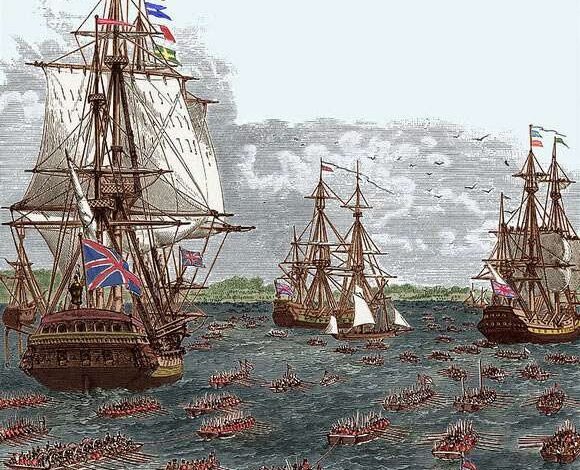Maritime Encounters Around Long Island During the American Revolution


 New York saw its fair share of military action during the American Revolution. This spring, Dr. Daria Merwin, an underwater archaeologist by training and Co-Director of the Cultural Resource Survey Program at the New York State Museum spoke at the Museum about maritime military encounters that pitted Revolutionaries against full might of the British Navy.
New York saw its fair share of military action during the American Revolution. This spring, Dr. Daria Merwin, an underwater archaeologist by training and Co-Director of the Cultural Resource Survey Program at the New York State Museum spoke at the Museum about maritime military encounters that pitted Revolutionaries against full might of the British Navy.
What follows is extracted from her talk, which you can find here in its entirety.
At the start of the Revolution, the city of New York with its year-round port was already a major hub of coastal and transatlantic trade was ideally located to facilitate military control of both the northern and southern colonies, so the waters around Long Island and especially New York Harbor were among the first places the British sought to control.
The Battle of Long Island (Battle of Brooklyn) took place in August of 1776 and resulted in the British occupation of the city. British 
 soldiers were ordered to destroy every ship and boat wharf, naval store and warehouse on Long Island to prevent the patriots from raising a navy.
soldiers were ordered to destroy every ship and boat wharf, naval store and warehouse on Long Island to prevent the patriots from raising a navy.
The Whaleboat War
The British efforts were not entirely successful and patriots who remained on Long Island under British military rule did not sit quietly. Guerrilla warfare was conducted on the waters of Long Island and the vessel most often used was small open whaleboats.
These small craft, propelled by sail or rowed, were used for espionage, smuggling and even kidnapping although their prime activity was raiding. They were fast and silent and could be hauled overland and easily hidden.
The advantages of the whaleboat ensured that it would be in use for decades after the Revolution and even after the demise of the whaling industry on Long Island. The direct descendant of the 18th century whaleboat was the lifeboat used well into the 20th Century.
One particularly successful whaleboat raid took place in November 1780 when the city of New York and Long Island were still occupied by the British. Major Benjamin Tallmadge put 80 men of the Second Continental Light Dragoons in eight whaleboats.
They crossed Long Island Sound from Connecticut, landing at Old Man’s Harbor (now Mount Sinai Harbor) on the north shore of Long Island with their objective to attack Fort St. George at Mastic on the South Shore occupied by a loyalist and used as a provisioning depot for the British in Suffolk County.
Poor weather forced Tallmadge’s troops to remain hidden for a day but they surprised and easily captured Fort St. George at dawn on November 23rd. On their return to their hidden whaleboats after taking the fort, the Revolutionaries destroyed 300 tons of hay that had been collected for British use.
Tallmadge returned to Connecticut with 54 prisoners and only one man wounded. The raid killed or wounded seven loyalists.
Perhaps the best known naval event of the Revolutionary War on Long Island waters is the loss of the HMS Culloden, a British 74-gun ship of the line stationed with a small squadron in Gardner’s Bay between the forks of Eastern Long Island.
The term “74-gun ship of the line” comes from the military naval tactic of lining up against your enemy and just trying to pound them into oblivion with cannonades. The 74-gun ship was one of the keys to British naval success – it was small enough and light enough to be easily maneuvered, but heavy enough to carry a broad assortment of different cannon.
In January 1781 the British learned that three French vessels were preparing to leave Newport, Rhode Island and headed to engage the British in Virginia. Three British ships Culloden, Bedford and America were dispatched to give chase and attempt to capture the French ships.
Soon after leaving Gardener’s Bay the British ships were engulfed in a bitter snowstorm.
The report of the French maneuvers may have been a ruse to lure the British ships into the storm and delay their departure south. Intelligence reports indicated the French vessels reversed course and returned to Newport.
In any event, the unscathed America was swept out to sea and eventually made landfall in the Northern Carolina capes. The Bedford was driven close to shore at the eastern tip of the South Fork of Long Island, although she was secured by anchor before the ship was dashed onto the rocky shoreline.
The Culloden did not fare so well. In the midst of the storm Captain Balffor mistakenly believed the ship had cleared Montauk Point, the very farthest eastern tip of Long Island, when the alarm of land and breakers upon the lee bow was given.

 The anchors were dropped immediately, but to no avail as Culloden struck ground at North Neck, today known as Culloden Point.
The anchors were dropped immediately, but to no avail as Culloden struck ground at North Neck, today known as Culloden Point.
Attempts to free Culloden following the storm were unsuccessful as the ship was pinned by a large rock and water slowly filled the hold. The crew was ordered to remove Culloden‘s stores and provisions along with anything else they could, including cannon, spars, rigging and other portable ship-board equipment.
The remaining hulk was burned to the water line to prevent salvage by the Revolutionaries.
The abandonment operation lasted nearly a month, during which time at least eight men deserted the Royal Navy. They are believed to have probably sought refuge with local families in East Hampton.
While the British were busy regrouping, in February the French seized the opportunity to sail past Long Island without interference and headed for Virginia. The British
left their station in pursuit the following month, having failed in their duty to keep the French confined to Rhode Island.
The French ships arrived in Virginia to support the larger French naval force outside of Yorktown. The wreck of Culloden is a popular spot for wreck diving.
Other Shipwrecks
There are other Revolutionary War era shipwrecks in Long Island waters. One that people have been searching for for centuries is the British frigate HMS Husar.
That vessel was reputed to have been carrying gold to pay the troops, and is believed to have been lost in the then dangerous waters around Hell Gate, where the East River enters Long Island Sound.
Read more about shipwrecks or archaeology in New York State, or about the American Revolution.
Illustrations, from above: British fleet arrives in New York Harbor, July 1776; British troops landing from the fleet for the Battle of Long Island in August 1777; a map of Long Island during American Revolution; Diorama of HMS Culloden shipwreck at the East Hampton Marine Museum.
Source link





